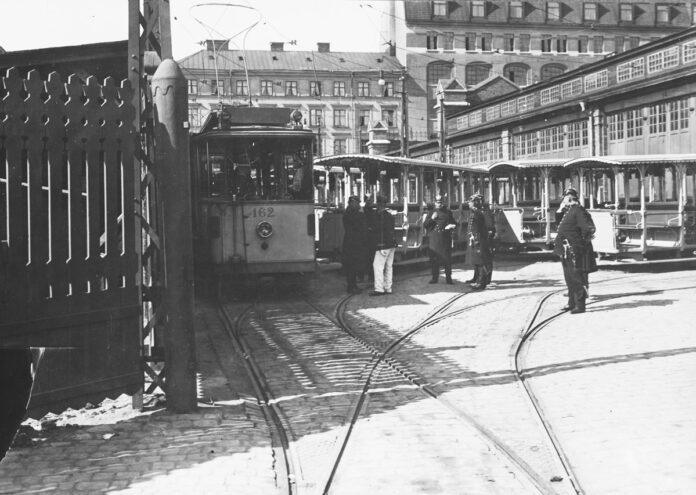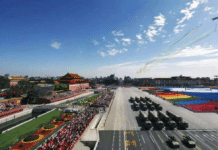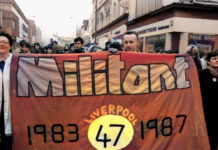Down with the weapons! With this slogan, the socialist youth movement in Sweden ran a mass campaign that secured peace with Norway in 1905. The socialist youth movement called for a general strike to prevent a war.
Per Olsson, Rättvisepartiet Socialisterna (ISA in Sweden)
Editors’ note: This article was first published in Rättvisepartiet Socialisterna’s and ISA’s weekly newspaper, Offensiv, in Sweden.
“Down with the weapons!” With this slogan, the socialist youth movement in Sweden ran a mass campaign that secured peace with Norway in 1905. The socialist youth movement called for a general strike to prevent a war and that any mobilisation should be met by a refusal to obey orders and that “weapons — if they are to be aimed at anyone — should not be directed at the Norwegians.”
The campaign and the support of Swedish workers for Norway’s obvious right to national self-determination enabled a peaceful dissolution of the so-called Union between Sweden and Norway in 1905. It was a victory for workers’ solidarity and the socialist peace struggle that resonated internationally.
The year 1905 began with the revolt of the Russian people. For Sweden, the year was full of confrontations — which all ended in victory for the labour movement, writes Kalle Holmqvist in the preface to his book, Fred med Norge [Peace with Norway] (Murbruk, 2015). One of these important victories was the peaceful dissolution of the Union between Sweden and Norway.
The end of the class struggles of 1905 marked a new chapter in Swedish history. Not least the dissolution of the Union contributed to the breakthrough of the socialist workers’ movement in general and the breakthrough of the socialist youth movement in particular.
Background: Norway’s struggle for independence
On 7 June 1905, the Union between Sweden and Norway was formally dissolved. The Union was formed in 1814 after Sweden was given Norway as a war booty at the Treaty of Kiel in January of the same year. “Norway was ceded to Sweden by the monarchs during the Napoleonic wars, against the will of the Norwegians; and the Swedes had to bring troops into Norway to subdue her”, wrote Russian revolutionary leader Lenin in his book, “The Right of Nations to Self-Determination” from 1914.
But the inhabitants of Norway, who had previously been under Danish sovereignty, wanted something different and proclaimed a free Norway. On 17 May 1814 (which officially became Norway’s National Day in 1836), a constitutional assembly in Eidsvoll was convened, a king was elected, and a constitution was adopted that was “unusually democratic for its time”, especially in comparison with the Swedish parliament. But it was still a long way from the breakthrough of democracy. Women had no voting rights at all. Only half of the men were allowed to vote.
However, Norwegian independence was defeated by the Swedish military and after a short war, an agreement was reached in August which saw the Swedish king become king over both countries. But Norway was allowed to keep its army, its Storting [parliament] and its new constitution. However, the two countries would have a common trade and foreign policy.
It was a settlement full of contradictions. The expansion of capitalism and the emerging bourgeoisie’s growing demands for democratic freedoms and rights in both Norway and Sweden would inevitably come into conflict with the monarchy that was to hold together the Union and the Great Swedish dream that Norway would become part of the “Swedish Kingdom” — just as Finland was until 1809.
The right of all peoples to national self-determination, including the formation of their own state, is a democratic demand which, from the outset, was part of the political programme of the socialist workers’ movement. By becoming the main advocates of democracy and national self-determination under the banner of revolutionary socialism the workers’ organisations were able to unite the workers against nationalism and draw a red line against the bourgeois forces that tried to portray themselves as uncompromising fighters for democracy.
From the end of the 1800s, these tensions led to constant conflicts and threats of war. Reluctantly, the head of the so-called double monarchy, King Oscar II, had to accept that Norwegian autonomy was expanded from the mid-1880s. The only exception was foreign policy, which was still governed by Stockholm — by the King and his government.
Beginning of the end for the Union
But as early as 1895, a serious crisis broke out after Venstre [the Liberal Party] won the election and was to form a government, which King Oscar II completely opposed. Plans were drawn up for a military intervention in Norway and defence spending were doubled.
The bourgeois liberal party, Venstre, Norway’s oldest party, also quickly became the country’s largest party. The party drew support from the peasants and what was called the middle class as well as parts of the capitalist class. The party also appealed to the workers, but soon faced competition from the Social Democratic Party, which was formed in 1887 and which, from 1891, became the Labour Party.
The Norwegian right also had its party, Høyre, which brought together the part of the upper-class and bureaucracy that feared that democracy and independence would be the gateway to a republic and social liberation.
In Sweden, the mood after the Liberal Party’s election victory became “purely warlike”, writes Börje Isaksson in his excellent book about the year of revolution — 1905. The Social Democratic Party in Sweden, which was formed in 1889, responded to war propaganda with meetings and demonstrations in support of Norway.
The Social Democrats then were a completely different party than they are today. It was a workers’ party that united the socialists of that time.
The party accommodated both revolutionaries and those who were strongly influenced by revisionism and reformism, which would later become dominant in the party’s leading circles and lead to the degeneration of social democracy.
On 1 May 1895, the leader of the Social Democrats, Hjalmar Branting, warned that if the ruling class started a war against Norway, they should expect that the soldiers would turn their weapons against those in power. Branting’s warning caused the bourgeoisie to hit the roof and call for harder measures against “the socialist heresies”. Branting was prosecuted and serviced with significant fines.
Later in the autumn of 1895, however, an agreement was reached between the king and the Storting and a new coalition government was formed. The threat of war was no longer immediately present, but the Union’s days were numbered.
The demand that Norway should have its own foreign representation, a consular service, marked a watershed. The Norwegian bourgeoisie wanted their own diplomats with the task of promoting the country’s trade and shipping, as Norway then had the world’s third largest merchant fleet. But the Swedish monarchy flatly said no.
At the same time as all attempts to reach an agreement on the consulate issue failed, Norway’s democratic lead over Sweden increased. In Norway, universal suffrage was introduced for men in 1899 and two years later, women were given municipal suffrage. In Sweden at the same time, 94 percent of the adult population lacked the right to vote.
Uptick in struggle and growth of workers’ movement
“In the spring of 1905, Sweden is surrounded by revolts. In the east, the strikes by Russian workers, which soon spread to Poland, the Baltics and Finland. In the West, there is a growing Norwegian consensus that self-government must be expanded. In March, Norway will have a new coalition government, whose goal is to create its own Norwegian consular service”, writes Kalle Holmqvist.
At home, battles emerged on numerous fronts. The government planned to introduce a new anti-strike law which entailed a strike ban for state and municipal employees. It should be added that the employers, led by Verkstadsföreningen, intended to try to smash the unions with the help of a widescale lockout.
The unions in Sweden had grown at an unprecedented rate. Between 1900 and 1907, the number of organised workers increased from 68,500 to 230,700. Measured in terms of the number of organised workers, the Swedish trade union movement was the world’s strongest. But it was still essentially a male labour movement and women had to fight not only against the employers, but also against male union leaders who were, to say the least, lukewarm about opening up unions for women and fighting for women’s suffrage.
The Social Democrats and the two youth unions, the Social Democratic Youth Union, and the Young Socialists, also grew in number. The Social Democratic Youth Union, the larger of the two socialist youth organisations, was formed in 1903 and in 1905 had as many as 5,000 members and 89 local organisations. The Social Democratic Youth Union’s weekly magazine had a wide circulation of 20,000.
The struggle in Sweden in 1905 also received impetus from the outside, mainly from the Russian revolution at the beginning of the year. In April, opposition to the new anti-strike law bore fruit. The proposal was rejected in the directly elected, Second Chamber of the Parliament, where there were four Social Democrats. It was a tremendous success for the workers’ movement.
A few weeks later, on 18 May, the Norwegian parliament passed a bill on its own consulates. Oscar’s answer was: “I do not accept the Storting’s decision”, whereupon the Norwegian government resigned. “Oscar II refuses to accept the resignation and it is really now that the Union is falling.” On 7 June, the Storting then made the formal decision to dissolve the Union and depose the king.
The Social Democrats and Branting, who had previously constantly wavered over the question of whether to dissolve the Union or not, immediately gave their full support to Norway’s decision. The Swedish right, on the other hand, made no secret of the fact that it was prepared to take military action against what was called the “coup” or the “revolution” in Kristiania (Oslo). For the Swedish capitalist class and the aristocracy, ITS prestige and International reputation were also at stake.
Workers’ unity vs. ruling class chauvinism
At the same time as the right and the ruling class did everything to whip up a chauvinist and bellicose mood with rallies for their “revered, old Union monarch”, they appealed to the authorities to put down the “unpatriotic” social democracy’s sympathies for revolutionary Norway.
At the forefront of the socialist movement’s resistance to the heat of war and Great Swedish revanchism was the Social Democratic Youth League, who printed and distributed 100,00 copies of their manifesto, “Down with the Weapons — Peace with Norway.” The youth union urged the working-class youth to refuse orders in the event of a general mobilisation and raised the demand for a major strike if the plans for war were implemented. The Young Socialists, who were influenced by anarchist ideas, also called for a strike and a refusal to obey orders.
The struggle of the youth pushed the Social Democratic Party to not only speak out, but to act. Large peace demonstrations and meetings were organised around the country. In Gothenburg, tens of thousands gathered at a demonstration meeting that sent the following greeting to the Norwegian Labour Party: “It was the upper-class Union that broke. The workers’ union is stronger today than ever.”
The mass movement that was formed and which also spread to the “comrades in tunics” [i.e. soldiers] both divided and weakened the Swedish authorities. The Royal House was paralysed. In the end, the right was forced to give up the idea of getting an excuse to invade Norway by issuing ultimatums.
Another important reason for the split at the top is that the employers (Verkstadsföreningen) had in June locked out 18,000 workers at 100 engineering companies. It was the largest labour dispute to date in Sweden. Fearing a two-front war, the right-wing newspapers had appealed to Verkstadsföreningen to postpone the big lockout for at least two weeks. The employers, however, expected that the strike fund would soon deplete and that the workers would break after a few weeks. But the opposite happened.
The unions had strong support in Sweden and abroad. As an expression of real solidarity, for example, Norwegian workers began to collect money for their Swedish comrades. “The Norwegian LO [TUC] decides on 16 June that all unions must charge an extra weekly fee of at least 25 öre per member: The money will go directly to the Swedish metal workers” according to Fred med Norge. Instead of breaking the unions, it was the employers who were “tormented”, an expression that one of them later used.
After a few months, a wounded Verkstadsföreningen was forced to accept both the right of association and parts of the workers’ wage demands. Prior to that, the King and the government had felt compelled to enter negotiations with the Norwegian government on the condition that a Norwegian referendum be held. The Swedish demand for a referendum was seen as an insolent provocation and was met with anger in Norway, where it was quite clear what the inhabitants wanted — a free country.
“Powerful without room for manoeuvre” is Kalle Holmqvist’s apt description of the position that the monarchy and the rulers had ended up in. The referendum held on 13 August, where the day before there had been large demonstrations in support of the Storting, ended in what must be history’s biggest “Yes”-victory. The turnout was 85 percent. Of the 371,911 people who participated, 368,208 voted in favour of the dissolution of the Union and 184 against. However, only men were allowed to participate due to the reluctance of the bourgeois-led Storting and their constant hesitation when it came to the task of doing away with the old. This was also the reason why they wanted Norway to become a monarchy and not a republic.
Norwegian women’s organisations instead conducted their own petitions and got an incredible 280,000 names in support of the decision on 7 June. No wonder that one of the right-wing MPs resignedly stated that we can conquer Norway, but not keep it. The most hard-line members of the bourgeoisie could not close their eyes to the state of public opinion in Norway could not even at home, “popular opinion was decidedly against war” (Hjalmar Palmstierna MP, quoted in Fred med Norge).
The negotiations that followed in the autumn of 1905 on what would apply after the dissolution of the Union were initially surrounded by troops at the border and a war mobilisation. But during the negotiations, the troops withdrew and the Swedish ruling class, which was most interested in saving face, had to sign an agreement on 23 September 1905.
The workers’ Union from below had ensured a peaceful separation, of which there are very few examples in history. The victories in 1905 became a breakthrough for the socialist organisations in both Sweden and Norway, which would not have been possible without the workers’ Union from below that was formed for peace with Norway.
Or as Lenin wrote in “The Right of Nations to Self-Determination”: “The close alliance between the Norwegian and Swedish workers, their complete fraternal class solidarity, gained from the Swedish workers’ recognition of the right of the Norwegians to secede. This convinced the Norwegian workers that the Swedish workers were not infected with Swedish nationalism, and that they placed fraternity with the Norwegian proletarians above the privileges of the Swedish bourgeoisie and aristocracy. Norwegian and Swedish workers. The Swedish workers have proved that in spite of all the vicissitudes of bourgeois policy they will be able to preserve and defend the complete equality and class solidarity of the workers of both nations in the struggle against both the Swedish and the Norwegian bourgeoisie.”




